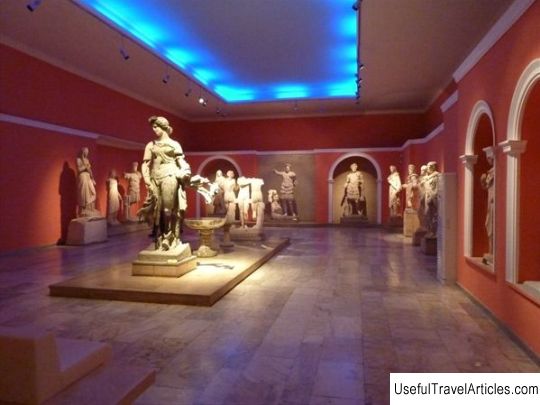Archaeological museum description and photos - Turkey: Antalya
Rating: 9,6/10 (8764 votes) 
Archaeological museum description and photos - Turkey: Antalya. Detailed information about the attraction. Description, photographs and a map showing the nearest significant objects. The title in English is Archaeological museum. Photo and descriptionAntalya Archaeological Museum is located on a mountain in the western part of the city in the Konyaalti region. This is one of the most important attractions in Antalya. The history of the museum begins in 1919, when Antalya was occupied by Italian troops. At that time, Italian archaeologists arrived in the city in order to collect the maximum number of artifacts found during excavations and took them to Italy. Suleiman Fikri Bey, who was the teacher of the Sultan of the Ottoman Empire, managed to prevent the export of cultural heritage. Later, the collection was located in the Tekeli Mehmet Pasha mosque, and the museum received its official status in 1937. The museum has over 2000 exhibits. Archaeological work continues, which brings new exhibits to the museum. Currently, this museum is the largest in Turkey and is one of the most famous museums in the world. The museum has 13 halls that occupy an area of 7000 sq. m. Hall 1 - Children's. The artifacts of this room are ancient piggy banks and toys. Children are given the opportunity to mold a vase or figurine from clay or draw themselves. Created creations can be donated to a museum, or you can take them as souvenirs. Hall 2 - Natural history and prehistoric times. The hall will be interesting for lovers of ancient history. The exhibits include parts of the skeleton and teeth of a Neanderthal man, diggers, axes, scrapers, arrowheads and other tools dating back to different centuries. Hall 3 - Miniatures-1. This room displays the entire history of the evolution of ceramics, from the 12th century to BC. Vases and various decorations of all sizes are presented. Hall 4 - Gods. All the exhibits in this room are associated with the gods of antiquity: figurines depicting gods; black cubes, which are the symbol of the battle of the Amazons; as well as griffins, magnificent vases, etc. Hall 5 - Miniatures-2. Here are selected works, vases and figurines, jewelry and dishes. One of the exhibits in this room is a silver plate engraved with the head of the goddess Athena. In the center of the room are the articles of Zeus, Aphrodite, Artemis, Fortune and other gods. A bronze statue of Hercules was raised from the bottom of the sea at Foca. Also, statues of Apollo and Hermes are made of bronze. There is also an underwater showcase with exhibits that were found on sunken ships. Among the exhibits there are many silver and gold jewelry. Hall 6 - Emperors. The room displays portraits, busts, statuettes and sculptures of emperors made of marble, clay and plaster. Portraits of Sabina, Faustina, Adrian, Trajan and others. Hall 7 - Sarcophagi. On display are sarcophagi dating back to the times of the Roman Empire. You can also see urns and funeral steles here. Hall 8 - Icons. The hall contains many icons. Hall 9 - Mosaic. A variety of ancient mosaics are presented. The main exhibit of this hall is a mosaic, from which the names of philosophers are composed. Hall 10 - Coins. The oldest coin presented in this room is more than 2500 years old. Halls 11-13 - The combination of three halls forms the ethnography department.
        We also recommend reading Church of St. Michael the Archangel in the village of Gniezno description and photos - Belarus: Grodno region Topic: Archaeological museum description and photos - Turkey: Antalya. |




